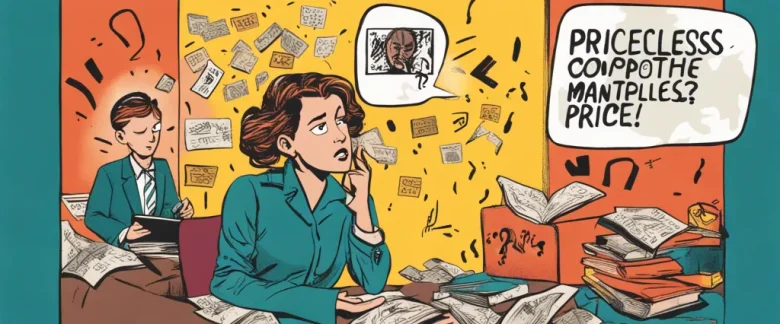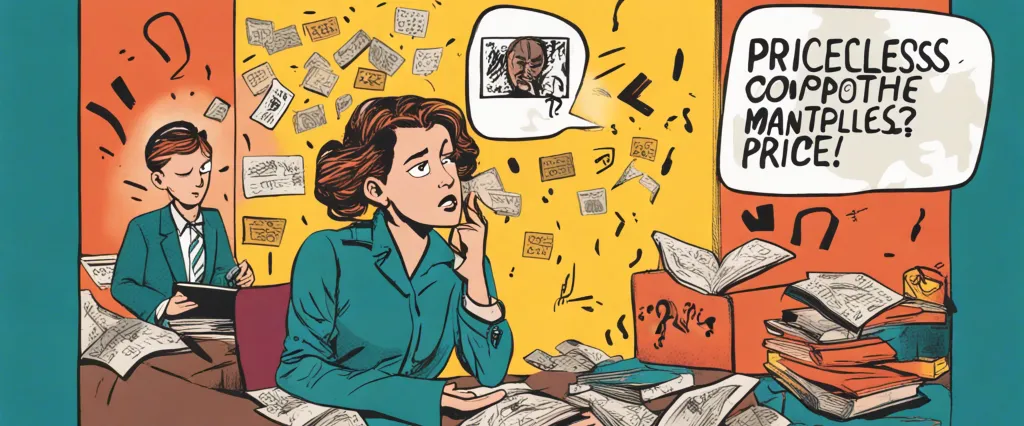In “Priceless,” author William Poundstone skillfully dismantles the notion of objectivity in pricing, revealing the hidden forces shaping our purchasing decisions. In his captivating examination of the psychology behind pricing strategies, Poundstone artfully exposes the deceptive tactics employed by businesses, shedding light on the true value of commodities. As an acclaimed author and journalist specializing in the intersections of science, psychology, and economics, Poundstone employs his expertise to unveil the manipulative techniques businesses employ to influence consumer behavior and extract maximum profit.
Chapter 1: The Power of Priceless
Chapter 1 of the book “Priceless” by William Poundstone, titled “The Power of Priceless,” explores the concept of pricing and its effect on human psychology. Poundstone begins by introducing the case of the missing Vanity Fair cover. In 2007, editor Graydon Carter decided not to include a cover price on the July issue, resulting in a surge of pickpocketing incidents as people assumed it was free. This incident highlights the power of pricing and how consumers perceive value.
The chapter then delves into the psychology of pricing, discussing the impact of the “charm price,” which is a price ending in 9 or 99 cents. Poundstone explains that consumers tend to perceive such prices as significant discounts, even though the actual difference may be minimal. He explains that people perceive prices relative to their expectations, and charm prices manipulate these expectations, making consumers more willing to buy.
Poundstone also explores the concept of “price anchors,” where a higher-priced item is intentionally displayed next to a lower-priced item to make the latter appear more attractive. He discusses how businesses utilize this strategy to influence consumer decision-making and increase profitability.
Additionally, the chapter introduces the concept of “mental shortcuts” or cognitive biases that shape our perception of prices. The author explains the anchoring effect, where the initial price we see influences our willingness to pay for subsequent items. He also mentions the decoy effect, where an inferior choice is presented to make another option seem more appealing.
Overall, Chapter 1 of “Priceless” offers a thought-provoking exploration of the psychology of pricing, highlighting how subtle manipulation techniques can significantly impact consumer behavior and the perception of value. The author sets the stage for further discussions on pricing strategies and their implications in business and everyday life.
Chapter 2: The Art of Pricing
Chapter 2: The Art of Pricing from the book Priceless by William Poundstone delves into the psychology behind pricing strategies and how they influence consumer behavior. Poundstone begins by highlighting the deceptive nature of prices and how they can be manipulated to maximize profits.
The chapter explains the concept of “anchoring,” which refers to the human tendency to rely heavily on the first piece of information presented to them. Poundstone provides examples where luxury brands deliberately set their prices exorbitantly high to create an anchor that makes their slightly less expensive products appear more affordable and attract a broader customer base.
Pricing is also heavily influenced by context. Poundstone discusses how context can evoke different psychological responses in consumers. For instance, a $500 bottle of wine may seem outrageously expensive at a grocery store, but is seen as a bargain at an upscale restaurant. This context shifting can alter consumers’ perceptions and willingness to pay.
The author also explores the power of “charm prices,” which are prices that end with the number 9. Poundstone reveals that these prices suggest a discount, even if the reduction in value is minimal. Consumers tend to perceive these prices as being significantly lower than they actually are, ultimately leading to increased sales.
Furthermore, Poundstone introduces the concept of “price framing,” where prices are presented in a way that appeals to consumers’ sense of value. By offering different pricing tiers with varying features, companies can guide consumers towards the option they consider the best value for their money.
In summary, Chapter 2 examines the art of pricing by exploring psychological tactics used by businesses to influence consumer behavior. Anchoring, context manipulation, charm prices, and price framing are all strategies that companies employ to maximize profitability through pricing. The chapter highlights the importance of understanding consumer psychology and how it plays a significant role in the success of pricing strategies.
Chapter 3: The Price of Everything
Chapter 3 of “Priceless” by William Poundstone, titled “The Price of Everything,” delves into the concept of pricing and explores how prices are determined for various goods and services. Poundstone raises intriguing questions about how we assign value to things and how businesses strategically set prices to maximize profits.
The chapter begins by analyzing the pricing strategy employed by retailers in a supermarket. Poundstone highlights that products’ prices are not simply derived from their production costs but rather from a combination of factors, including customer psychology and market competition. Retailers utilize these factors to manipulate prices in order to increase sales and profits. Poundstone emphasizes that the perception of prices greatly affects customers’ decision-making processes.
The author then expands on the concept of anchoring, which is the tendency to rely heavily on the initial piece of information offered when making judgments or decisions. Poundstone cites experiments conducted by psychologists that demonstrate how anchoring influences pricing decisions. By placing a high-priced item next to a lower-priced one, retailers can make the latter appear like a better deal, even when it may not be objectively true.
Additionally, the chapter focuses on the use of price discrimination, a strategy where businesses charge different prices to different customers for the same product. Poundstone explains that price discrimination is common in industries such as airlines, where various factors like time, competition, and customer behavior influence pricing decisions. The author refers to early computer sales, where customers were asked to pay significantly more for a computer with the same performance, merely because they were willing to pay more.
Overall, Chapter 3 of “Priceless” explores the intricacies behind pricing strategies, highlighting how businesses utilize psychological tactics and market analysis to price their products or services. It sheds light on the complex relationship between consumers and prices and encourages readers to question the true worth of the goods we purchase.
Chapter 4: The Price of Life

Chapter 4 of “Priceless” by William Poundstone, titled “The Price of Life,” explores the concept of assigning monetary value to human life. Poundstone delves into the history and controversies surrounding the calculation of a human life’s worth.
The chapter begins by highlighting the origins of life valuation, tracing it back to 17th-century Scotland. Early life insurance policies provided financial compensation to families in case of the policyholder’s death, giving rise to the need for determining a person’s value. Recognizing the difficulties in doing so, Poundstone introduces the concept of “stochastic morbidity” – the statistical assessment of an individual’s chances of dying or surviving.
Poundstone then delves into the modern methods used to assign a price to life, focusing on the work of economist Thomas Schelling and his hypotheses. Through Schelling’s analysis of society’s response to risk, particularly in situations involving public health, Poundstone draws attention to the monetization of life-saving tactics. He lays out the differing perspectives on valuing life, such as the cost of medical treatment, determining compensation in court cases, or policies surrounding the environment.
Throughout the chapter, Poundstone challenges the ethics and fairness of such calculations. He highlights the potential pitfalls associated with giving a standard monetary value to human lives, as it can overlook important factors like age, income, and contributions to society. The author also underscores the inherent inequality in life valuation, where certain individuals or groups may be assigned a lower worth based on societal biases.
In conclusion, Chapter 4 provides an overview of the history and complexities involved in placing a price on human life. It highlights the ongoing debates and considerations surrounding this issue and raises important questions about the moral implications of commodifying something as valuable as life itself.
Chapter 5: The Price of Fame
Chapter 5: The Price of Fame of the book Priceless by William Poundstone explores the concept of fame and its effects on the economy and the value of certain possessions. Poundstone highlights how the perceived value of an item can drastically increase simply because it was owned or used by a famous person.
The chapter begins by discussing the phenomenon of auctions and how they function as a mechanism for determining the value of items. Poundstone introduces the concept of celebrity auctions, where personal belongings or memorabilia of famous individuals are sold to the highest bidder. He explains that the value of an item in these auctions is not based solely on its physical attributes, but rather on the fame and perceived significance of the individual who owned it.
Poundstone examines various examples of celebrity auctions, such as Marilyn Monroe’s dress and Elvis Presley’s guitar, to illustrate the irrationality of the prices paid for these items. He suggests that buyers are motivated by the desire to possess a piece of someone else’s fame, creating a demand that drives up prices to extraordinary levels.
The chapter also delves into the psychological aspects behind the value of fame. Poundstone explores the social and cultural significance of celebrity worship, noting that people derive a sense of identity and connection from associating themselves with famous individuals. This connection, he argues, is why people are willing to pay exorbitant amounts for items connected to these celebrities.
Overall, Chapter 5 of Priceless emphasizes how fame can distort the market and inflate the values of otherwise ordinary objects. Poundstone raises questions about the nature of fame and its impact on our understanding of value and worth.
Chapter 6: The Price of Trust
Chapter 6 of “Priceless” by William Poundstone, titled “The Price of Trust,” delves into the concept of trust and how it shapes our perception of value and willingness to pay more for certain goods and services. Poundstone explores various experiments and case studies to uncover how trust influences consumer behavior and pricing strategies.
The chapter begins by discussing the concept of trustworthiness and its role in transactions. Trust is established through factors like reputation, brand, and social proof, which help sway consumer behavior and willingness to pay a certain price. Poundstone introduces various experiments where participants were more likely to pay higher prices for products from well-known brands due to their perceived trustworthiness.
He then delves into the concept of “price signaling,” which refers to how pricing strategies can either enhance or damage trust. Companies often use premium pricing as a way to signal their commitment to quality, leading consumers to view their products or services as more trustworthy. However, manipulating prices to boost trust can backfire if perceived as dishonest or manipulated.
Poundstone further explores the impact of trust in the real world, discussing the pricing strategies of companies such as Zappos, Costco, and Tiffany & Co. These companies aim to build trust with their customers by offering things like free shipping, return policies, and high levels of customer service. By investing in trust-building measures, these companies are able to charge higher prices and retain loyal customers.
Overall, Chapter 6 of “Priceless” highlights the crucial role trust plays in our perception of value and willingness to pay. Trustworthiness can be built through reputation, brand image, and ethical pricing strategies, ultimately allowing companies to charge higher prices while maintaining customer loyalty.
Chapter 7: The Price of Information
Chapter 7 of “Priceless” by William Poundstone, titled “The Price of Information,” delves into the concept of information asymmetry—the idea that one party possesses more information than the other, leading to imbalances in negotiations and transactions. Poundstone begins by discussing the importance of information in the marketplace, citing examples such as job interviews, product pricing, and insurance policies.
The chapter then explores how individuals and companies use information to gain advantages in various scenarios. Poundstone reveals how psychic hotlines, despite their fraudulent claims, manage to make millions of dollars by preying on people’s desires to know the future. He also highlights the practice of insider trading, where a person with confidential information about a company’s future performance buys or sells stocks to exploit this knowledge for personal gain.
Poundstone discusses the evolution of information-sharing platforms, emphasizing how the internet has revolutionized access to information. He explores the rise of crowdsourcing, explaining how companies like InnoCentive discovered that offering rewards to a large online community often yielded better solutions to complex problems.
The author goes further by providing examples of how information asymmetry affects medical treatments, where doctors often have more knowledge than patients, leading to potential biases and misinformed decisions. Poundstone emphasizes the importance of addressing information asymmetry by promoting transparency and providing accurate, reliable information to all parties involved.
In conclusion, Chapter 7 of “Priceless” exposes the implications of information asymmetry in various aspects of life and how it can lead to unequal outcomes. The author encourages a more open and transparent society to tackle the challenges posed by information imbalances and ensure fairer negotiations and transactions.

Chapter 8: The Price of Time
Chapter 8 of “Priceless” by William Poundstone, titled “The Price of Time,” delves into the concept of time and its monetary value in our lives. The author explores how people’s perceptions of time affect their behavior and decision-making, ultimately shaping their happiness and well-being.
Poundstone starts by examining the economic principle of opportunity cost, which suggests that every decision we make involves sacrificing other options. He provides examples of how people weigh their time based on its value: a CEO may value an hour of their time more than hiring a personal assistant, while someone earning minimum wage might prefer doing household chores rather than hiring help.
The chapter further explores the idea of “time poverty,” wherein individuals feel overwhelmed with commitments and struggle to find time for activities that give them joy. Time-saving technologies, such as the microwave oven, are often purchased to alleviate this constraint. However, they often create an ironic effect known as “time deepening,” where saved time is quickly filled with other tasks, leaving individuals feeling just as time-poor as before.
Poundstone also discusses research on the connection between time and happiness. Studies have found that individuals who prioritize time over money tend to report higher life satisfaction. The chapter delves into the reasons for this, such as the positive experiences derived from shared time and the ability to engage in personally fulfilling activities.
In the latter part of the chapter, Poundstone explores the paradox of leisure, wherein free time is often undervalued. He highlights how people who recognize the worth of their leisure time tend to experience higher levels of happiness. Additionally, the author introduces the “time-is-money illusion,” where individuals may overvalue their time, leading to unnecessary time-saving expenditures.
Overall, “Chapter 8: The Price of Time” emphasizes the significance of time in human lives. It prompts readers to reflect on their relationship with time, suggesting that by valuing and utilizing their time effectively, individuals can enhance their overall well-being and life satisfaction.
After Reading
In conclusion, “Priceless” by William Poundstone offers a captivating exploration of the concept of value and the role it plays in our daily lives. Poundstone masterfully dissects the intricacies of pricing strategies, illuminating how companies manipulate consumers’ perceptions and emotions to maximize profits. Through various examples and anecdotes, he demonstrates how individuals can make more informed choices in the marketplace and recognize the tricks employed by marketers. This thought-provoking book urges readers to question the true worth of products and services, empowering them to navigate the consumer-driven world more confidently. Ultimately, “Priceless” reminds us that while some things may indeed be priceless, it is crucial to understand the mechanisms that determine their perceived value.
1. Freakonomics: A Rogue Economist Explores the Hidden Side of Everything” by Steven D. Levitt and Stephen J. Dubner – This book combines economics with social issues and explores the unanticipated consequences of various phenomena, offering unique insights into the hidden side of everyday life.
2. Predictably Irrational: The Hidden Forces That Shape Our Decisions” by Dan Ariely – Similar to “Priceless,” Dan Ariely explores the irrational behaviors underlying our decision-making processes. Through engaging experiments and real-life examples, Ariely challenges traditional economic theories and examines our often-predictable irrationality.
3. The Tipping Point: How Little Things Can Make a Big Difference” by Malcolm Gladwell – In this book, Gladwell analyzes the unexpected change in trends and behaviors, focusing on the elements that contribute to a tipping point. Like “Priceless,” it examines the influential factors and hidden dynamics that shape our society.
4. Misbehaving: The Making of Behavioral Economics” by Richard H. Thaler – This book provides an overview of how traditional economic theory often falls short in explaining human behavior. Thaler, a leading figure in behavioral economics, showcases how individuals and markets often deviate from rationality, shedding light on the flaws inherent in classical economic models.
5. Influence: The Psychology of Persuasion” by Robert B. Cialdini – This classic book explores the tactics and psychological principles behind persuasion and influence. Similar to “Priceless,” Cialdini uncovers the hidden techniques used by salespeople, advertisers, and marketers to manipulate our decision-making process, providing readers with valuable insights into the power of influence.




